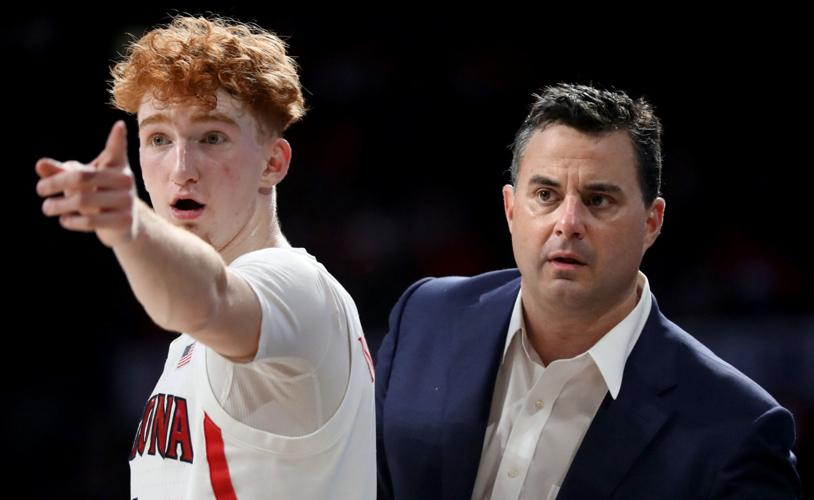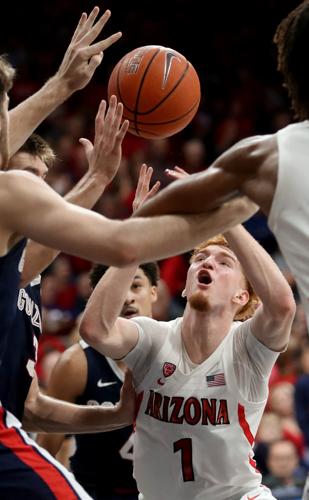Arizona debuted at No. 15 in the NCAA’s first NET ratings of the season, but the Wildcats aren’t the highest placed Pac-12 team. Nor is Oregon.
It’s Stanford. The Cardinal (9-1) was ranked No. 9 in the NET even though it has only beaten one Top 150 Kenpom team (Oklahoma) and is playing the 20th weakest schedule in Division I so far, according to Kenpom.
San Diego State, 10-0 yet ranked only No. 20 in the AP Top 25 poll, is third in the NET rankings behind only top-ranked Ohio State and Kansas.
But if the NET rankings appear a little off, that’s to be expected early in the season. The NCAA even waited an extra two weeks to start releasing them this season for the sake of accuracy, after they were widely panned after their first-ever release on Nov. 26, 2018.
Dan Gavitt, the NCAA’s senior vice president for men’s basketball, told NCAA.com that the NET rankings do not include any preseason rankings so they improve as more games are played. By the end of last season, he said, 14 of the top 16 teams in the NET rankings reached the Sweet 16 – and No. 18 Auburn was another.
“It seemed to perform quite well last year in its first year,” Gavitt said.
Gavitt said the NET was installed last year to replace the RPI as the primary sorting tool for evaluating potential NCAA tournament teams, since it is both predictive and reactive, including offensive and defensive efficiency, among other metrics. The RPI was strictly reactive.
NET ratings are used to construct a sorting tool for which to begin evaluating teams for selection in the NCAA Tournament — i.e., defining which of a team’s games are top-tier “Quadrant 1” based on the site and NET ranking of the opponent. The NET is also one of many metrics the selection committee ultimately uses for selection and seeding NCAA tournament teams.
Along with the NET ratings, the NCAA is now issuing “team sheets” breaking down how each team has done in each quadrant. UA is 0-2 in Quadrant 1 games (losing to Baylor and Gonzaga), but is 1-0 in Quadrant 2 (its Nov. 10 home win over Illinois). UA is also 5-0 in Quadrant 3 and 4-0 in Quadrant 4, and the average NET ratings of teams they have beaten is 157.
Quadrant 1 games are defined as those at home against teams rated 1-30, on neutral sites against teams ranked 1-50 and away at teams ranked 1-75. Quadrant 2 games are those at home against teams 31-75, neutral 51-100 and away 76-135.
Quadrant 3 represents games at home against teams rated No. 76-160, neutral games against teams 101-200 and road games against Nos. 136-240. Games against even lower-rated teams in each category are in quadrant four.
Following Stanford and Arizona, the Pac-12’s initial NET ratings included: Oregon 17, ASU 30, Colorado 31, Washington 35, Oregon State 40, Utah 54, USC 77, Washington State 133, UCLA 169 and Cal 182.
Wildcats slip to No. 16 in AP Top 25
Meanwhile, Arizona dropped one spot to No. 16 in the human-powered Associated Press Top 25 basketball poll after losing to Gonzaga on Saturday. The Zags (11-1) jumped from No. 6 to No. 2.
Oregon remains the top Pac-12 team in the AP poll, moving from No. 10 to No. 8 after winning at Michigan, 71-70 in overtime, on Saturday.
Washington is ranked No. 22 while Colorado fell out after losing at home to Northern Iowa.
Onyeka beats out Nnaji for Pac-12 honor
Team wins, especially those on the road, often weigh heavily in voting for the Pac-12’s weekly award and Arizona’s Zeke Nnaji didn’t have either factor to accompany his 16 points and 17 rebounds on Saturday against Gonzaga.
Instead, USC forward Oneyka Okongwu was named the Pac-12 Freshman of the Week after collecting 28 points and 12 rebounds in USC’s home win against Long Beach State, while Oregon guard Payton Pritchard was named the league’s overall Player of the Week after pouring in 17 of his 23 points after halftime to lead the Ducks over Michigan.
Arizona said that no other player has had as many as 16 points and 17 rebounds against a ranked team so far this season. But the way UA coach Sean Miller described it, the Wildcats would have had a better chance to get that team win Saturday if they had given Nnaji the ball more often.
Seven of Nnaji’s 16 points came as a result of his own offensive rebounds.
“We have to be better at getting him the ball when they can’t trap him, and that’s one of many regrets that I have about” Saturday’s game, Miller said. “When we really needed to be able to do that, we couldn’t do it and that hurt us.
“But Zeke, look, when you’re a freshmen, and you’re playing in a game of that magnitude against those guys, and you have 16 points and 17 rebounds — that’s one heck of a performance. I know we lost but ... I thought he was just a monster out there.”
Nnaji already has two Pac-12 freshman of the week awards, winning them on Nov. 11 and Nov. 18 during UA’s six-game homestand to start the season.





